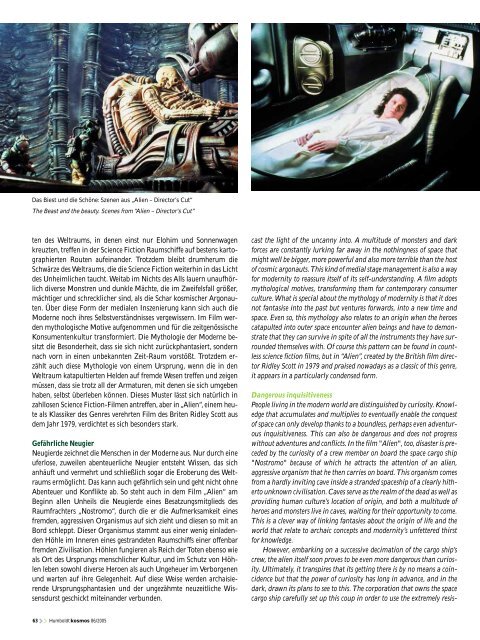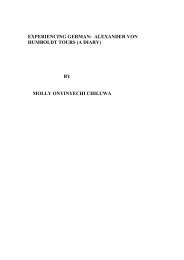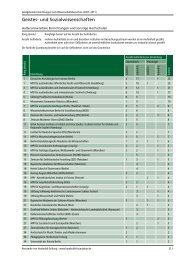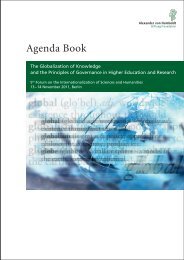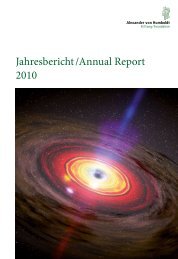50 - Alexander von Humboldt-Stiftung
50 - Alexander von Humboldt-Stiftung
50 - Alexander von Humboldt-Stiftung
Erfolgreiche ePaper selbst erstellen
Machen Sie aus Ihren PDF Publikationen ein blätterbares Flipbook mit unserer einzigartigen Google optimierten e-Paper Software.
Das Biest und die Schöne: Szenen aus „Alien – Director’s Cut“<br />
The Beast and the beauty. Scenes from “Alien – Director's Cut”<br />
ten des Weltraums, in denen einst nur Elohim und Sonnenwagen<br />
kreuzten, treffen in der Science Fiction Raumschiffe auf bestens kartographierten<br />
Routen aufeinander. Trotzdem bleibt drumherum die<br />
Schwärze des Weltraums, die die Science Fiction weiterhin in das Licht<br />
des Unheimlichen taucht. Weitab im Nichts des Alls lauern unaufhörlich<br />
diverse Monstren und dunkle Mächte, die im Zweifelsfall größer,<br />
mächtiger und schrecklicher sind, als die Schar kosmischer Argonauten.<br />
Über diese Form der medialen Inszenierung kann sich auch die<br />
Moderne noch ihres Selbstverständnisses vergewissern. Im Film werden<br />
mythologische Motive aufgenommen und für die zeitgenössische<br />
Konsumentenkultur transformiert. Die Mythologie der Moderne besitzt<br />
die Besonderheit, dass sie sich nicht zurückphantasiert, sondern<br />
nach vorn in einen unbekannten Zeit-Raum vorstößt. Trotzdem erzählt<br />
auch diese Mythologie <strong>von</strong> einem Ursprung, wenn die in den<br />
Weltraum katapultierten Helden auf fremde Wesen treffen und zeigen<br />
müssen, dass sie trotz all der Armaturen, mit denen sie sich umgeben<br />
haben, selbst überleben können. Dieses Muster lässt sich natürlich in<br />
zahllosen Science Fiction-Filmen antreffen, aber in „Alien“, einem heute<br />
als Klassiker des Genres verehrten Film des Briten Ridley Scott aus<br />
dem Jahr 1979, verdichtet es sich besonders stark.<br />
Gefährliche Neugier<br />
Neugierde zeichnet die Menschen in der Moderne aus. Nur durch eine<br />
uferlose, zuweilen abenteuerliche Neugier entsteht Wissen, das sich<br />
anhäuft und vermehrt und schließlich sogar die Eroberung des Weltraums<br />
ermöglicht. Das kann auch gefährlich sein und geht nicht ohne<br />
Abenteuer und Konflikte ab. So steht auch in dem Film „Alien“ am<br />
Beginn allen Unheils die Neugierde eines Besatzungsmitglieds des<br />
Raumfrachters „Nostromo“, durch die er die Aufmerksamkeit eines<br />
fremden, aggressiven Organismus auf sich zieht und diesen so mit an<br />
Bord schleppt. Dieser Organismus stammt aus einer wenig einladenden<br />
Höhle im Inneren eines gestrandeten Raumschiffs einer offenbar<br />
fremden Zivilisation. Höhlen fungieren als Reich der Toten ebenso wie<br />
als Ort des Ursprungs menschlicher Kultur, und im Schutz <strong>von</strong> Höhlen<br />
leben sowohl diverse Heroen als auch Ungeheuer im Verborgenen<br />
und warten auf ihre Gelegenheit. Auf diese Weise werden archaisierende<br />
Ursprungsphantasien und der ungezähmte neuzeitliche Wissensdurst<br />
geschickt miteinander verbunden.<br />
63 >> <strong>Humboldt</strong> kosmos 86/2005<br />
cast the light of the uncanny into. A multitude of monsters and dark<br />
forces are constantly lurking far away in the nothingness of space that<br />
might well be bigger, more powerful and also more terrible than the host<br />
of cosmic argonauts. This kind of medial stage management is also a way<br />
for modernity to reassure itself of its self-understanding. A film adopts<br />
mythological motives, transforming them for contemporary consumer<br />
culture. What is special about the mythology of modernity is that it does<br />
not fantasise into the past but ventures forwards, into a new time and<br />
space. Even so, this mythology also relates to an origin when the heroes<br />
catapulted into outer space encounter alien beings and have to demonstrate<br />
that they can survive in spite of all the instruments they have surrounded<br />
themselves with. Of course this pattern can be found in countless<br />
science fiction films, but in “Alien”, created by the British film director<br />
Ridley Scott in 1979 and praised nowadays as a classic of this genre,<br />
it appears in a particularly condensed form.<br />
Dangerous inquisitiveness<br />
People living in the modern world are distinguished by curiosity. Knowledge<br />
that accumulates and multiplies to eventually enable the conquest<br />
of space can only develop thanks to a boundless, perhaps even adventurous<br />
inquisitiveness. This can also be dangerous and does not progress<br />
without adventures and conflicts. In the film "Alien", too, disaster is preceded<br />
by the curiosity of a crew member on board the space cargo ship<br />
"Nostromo" because of which he attracts the attention of an alien,<br />
aggressive organism that he then carries on board. This organism comes<br />
from a hardly inviting cave inside a stranded spaceship of a clearly hitherto<br />
unknown civilisation. Caves serve as the realm of the dead as well as<br />
providing human culture’s location of origin, and both a multitude of<br />
heroes and monsters live in caves, waiting for their opportunity to come.<br />
This is a clever way of linking fantasies about the origin of life and the<br />
world that relate to archaic concepts and modernity’s unfettered thirst<br />
for knowledge.<br />
However, embarking on a successive decimation of the cargo ship’s<br />
crew, the alien itself soon proves to be even more dangerous than curiosity.<br />
Ultimately, it transpires that its getting there is by no means a coincidence<br />
but that the power of curiosity has long in advance, and in the<br />
dark, drawn its plans to see to this. The corporation that owns the space<br />
cargo ship carefully set up this coup in order to use the extremely resis-


